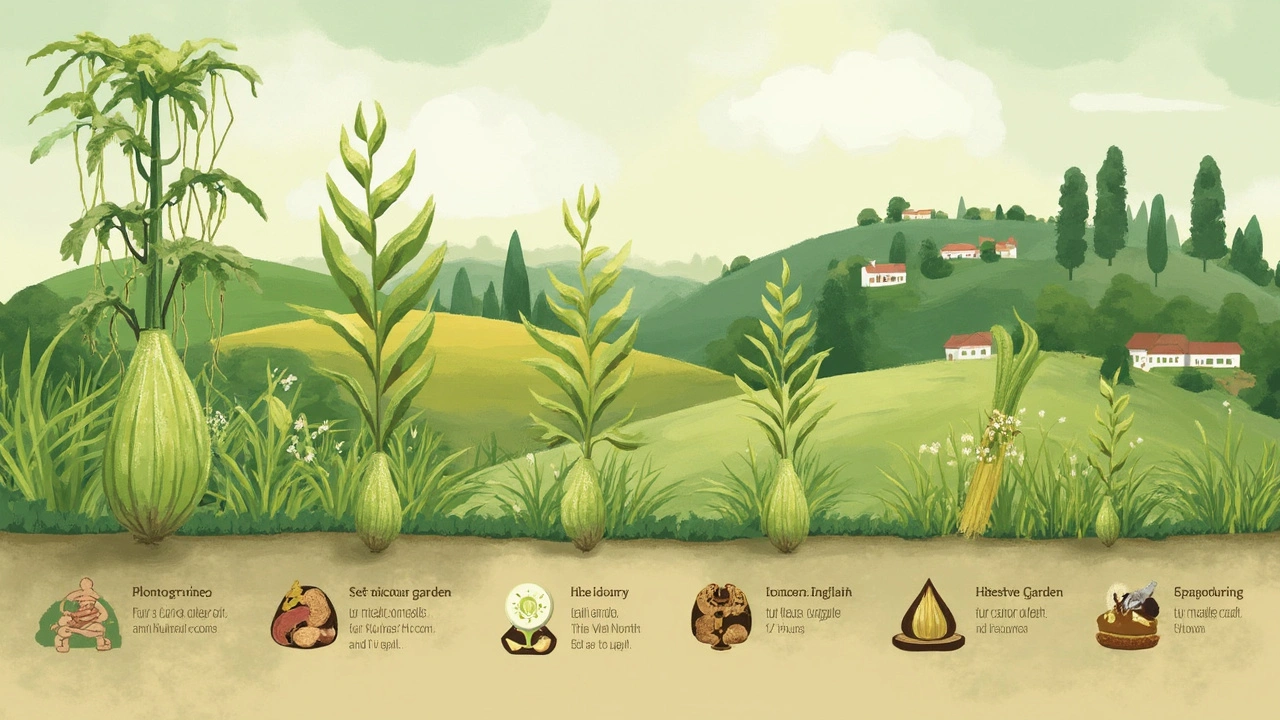Luffa: The Ultimate Guide to the World's Most Versatile Dietary Supplement

You might only know luffa as that scratchy thing in your shower, but it’s way more than just a sponge. Luffa is actually a plant from the same family as cucumbers and squash, and when it’s picked young, it packs a punch as a dietary supplement. People in Asia, Africa, and the Middle East have been eating it for centuries, not just scrubbing with it.
Now, luffa supplements are popping up everywhere—from powder blends you can stir into smoothies to capsules sitting next to your multivitamins. But why should you care? Because luffa is loaded with nutrients and fiber, and it’s gentle on the stomach. Think of it as a small way to add more plant power to your day without making big changes to your routine.
- What Actually Is Luffa?
- Nutrition Facts That Make Luffa Stand Out
- Health Benefits Backed By Real Science
- Safe Ways to Use Luffa in Your Diet
- Smart Shopping and Storage Tips
- Popular Myths and Fun Facts
What Actually Is Luffa?
Most people think of luffa as the rough, spongy thing that keeps your skin smooth. But when it comes to luffa as a dietary supplement, we’re talking about a plant, not a bathroom accessory. Luffa, or sometimes spelled "loofah," grows on a fast-climbing vine in warm climates. It’s actually related to cucumbers and zucchini. If you pick the fruit before it fully ripens, it’s soft and totally edible. Once it dries out, that’s when you get the famous scrubber for cleaning.
Luffa is most popular in parts of Asia like China, India, and Vietnam, and you’ll find it both in markets and kitchens. The fresh version looks like a big, ribbed cucumber and can grow over a foot long. While most American grocery stores don't have it next to the veggies, you can spot it in international food markets or as powders or capsules in the supplement aisle.
People eat luffa in all sorts of ways: sliced in stir fry, tossed in soup, or dried and ground up for dietary supplements. If you want to get technical, there are two big types: Luffa aegyptiaca (also called sponge gourd) and Luffa acutangula (ridge gourd). Both show up in supplements, though the ridge type is a bit more common for eating.
What makes luffa stand out as a nutrition source? It’s low in calories but isn’t just empty crunch. Luffa packs in fiber, vitamin C, and a handful of trace minerals. Check out this quick breakdown of fresh luffa’s basic stats per 100 grams:
| Nutrient | Amount |
|---|---|
| Calories | 20 kcal |
| Fiber | 1.3 g |
| Vitamin C | 12 mg |
| Potassium | 139 mg |
So, luffa isn’t just for exfoliating. It’s a real, edible plant that slips easily into your diet, especially if you want fiber and nutrients with barely any calories.
Nutrition Facts That Make Luffa Stand Out
Let’s get to the good stuff: what’s actually inside luffa that can help your health? Luffa is a real nutrition gem, especially if you’re trying to add more plants and fiber to your meals. When eaten young and tender (before it turns into the sponge), it’s loaded with stuff your body loves.
First up, luffa is super low in calories—just 20–25 calories for a whole cup, chopped up. That means you can fill up without packing on pounds. It’s also rich in water—over 85%, so it’s a good veggie if you want to stay hydrated.
Now, the fiber. Luffa is a sneaky way to bump up your fiber intake without a lot of work. One cup gives you around 2 grams, enough to help keep things moving in your gut and support gut-friendly bacteria. Extra fiber can also help curb cravings by making you feel full longer.
| Nutrient (per 100g) | Amount |
|---|---|
| Calories | 20 kcal |
| Water | 85 g |
| Fiber | 2 g |
| Vitamin C | 12 mg |
| Potassium | 140 mg |
| Vitamin A | 200 IU |
But there’s more. Luffa brings vitamin C to the table—enough to give your immune system a nudge and help your skin stay healthy. There’s potassium too, which your heart and muscles need. And for folks eyeing their vision, luffa has some vitamin A, just not enough to replace carrots.
- No cholesterol and barely any fat or sugar, so it’s friendly if you’re watching those numbers.
- Some trace minerals, like magnesium and calcium, chip in to keep bones and muscles working smoothly.
- Bonus: It even offers a few plant antioxidants (these guys fight off everyday cell damage from stress and junk food).
Bottom line: Adding luffa to your diet is a simple way to boost your daily nutrients without a bunch of extra calories, sugar, or chemicals. It’s naturally clean, easy on the gut, and fits pretty much any eating plan.
Health Benefits Backed By Real Science
Let’s get straight to the point: luffa is more than a trendy add-on in the world of dietary supplements. Its real power comes from its solid nutrition profile and the way it supports different parts of your health, all proven by research—not just old wives’ tales.
First, if you struggle with digestion, luffa is a real helper. It’s loaded with fiber, and that means it helps get things moving in your system, keeps you regular, and can help with bloating or that heavy, sluggish feeling. A study from a nutrition journal in China showed that folks adding luffa to their diets had an easier time with digestion compared to those who didn’t.
That’s not all. Luffa is packed with vitamin C—your go-to nutrient for keeping your immune system on its toes. One cup of cooked luffa can give you almost a quarter of your daily vitamin C needs. This vitamin is key for helping your body fight off colds and everyday bugs.
Luffa also packs potassium, magnesium, and a range of antioxidants. Potassium helps control blood pressure, while magnesium keeps your muscles and nerves in good shape. Antioxidants are your defense against cell damage—they keep you feeling and looking younger.
| Nutrient | Amount per 100g | Main Benefit |
|---|---|---|
| Vitamin C | 13 mg | Immune support |
| Potassium | 139 mg | Heart health |
| Magnesium | 11 mg | Muscle & nerve function |
| Fiber | 1.2 g | Digestion |
There’s another bonus: luffa is especially low in calories, with barely 20 calories per 100 grams. So you can add it to meals or supplements if you’re looking to manage your weight, without worrying about extra calories sneaking in.
In some early research, luffa has shown potential for helping to balance blood sugar—the fiber and micronutrients work together to slow the sugar rush after eating. That means it’s a smart add-on for anyone watching their blood sugar swings.
Bottom line? Luffa is more than just hype. It covers the basics like better digestion, immune support, and heart health, all while keeping things simple, natural, and low-cal. That’s why so many people are sliding it into their dietary supplement routine these days.

Safe Ways to Use Luffa in Your Diet
When it comes to actually eating luffa, don’t overthink it. Young luffa looks and tastes a lot like zucchini but with more crunch. You can toss it into stir-fries, stews, or soup the same way you’d use squash. But that’s not where it ends—these days, you’ll find luffa supplements in powders, capsules, and even teas.
Fresh luffa is most common in Asian markets. Look for ones about the size of your hand, with a bright green color and firm skin. Scrub it, slice it, and either eat it raw in salads or sauté it with garlic and a splash of soy sauce.
- Powdered luffa can be mixed into smoothies, oatmeal, or even yogurt. Most people start with 1-2 teaspoons a day—don’t go overboard until you know your gut handles the fiber well.
- Capsules are super easy: Just check the label for how many to take. Usually, it’s one to two per day with a meal.
- Luffa tea is a thing too. Grab a bag or make your own by simmering a few slices of dried luffa in boiling water for five to ten minutes.
It’s pretty safe for most folks, but if you’re pregnant, have food allergies, or deal with gut issues (like IBS), talk to your doctor first. High fiber can sometimes cause bloating if you’re not used to it, so start slow. A quick tip: Drink more water on days you have luffa, since fiber really works best with good hydration.
| Form | How to Use | Daily Amount (Suggested) |
|---|---|---|
| Fresh Luffa | Cooked in dishes or raw in salads | 1 cup (about 100g) |
| Powder | Add to smoothies or yogurt | 1-2 teaspoons |
| Capsules | Swallow with water/meals | 1-2 capsules |
| Tea | Brew dried slices | 1-2 cups |
If you’re not into the taste, using supplements lets you skip the prep and still get the fiber punch. Just don’t try to eat dried luffa sponges—they’re not processed for eating and can be tough on your stomach. Stick to food-grade luffa dietary supplement products, and steer clear of anything meant for scrubbing your pots or skin.
Smart Shopping and Storage Tips
Looking for the best luffa supplement can seem confusing with so many choices out there. First, check the ingredient list. You want pure luffa without weird additives or artificial flavors. Organic products usually have fewer pesticides, so that's a good bet if you care about clean eating. Powder and capsule forms both work, but make sure that the brand you pick is legit and has decent reviews. Nobody wants a supplement that's heavy on fillers and light on benefits.
Don’t fall for fancy packaging—what matters is what’s inside. If you’re buying fresh luffa (yes, it does show up in some supermarkets and Asian grocers), pick young, green gourds that feel firm. Skip the ones with brown spots or any softness; those are past their prime. Dried luffa is used for tea or cooking, so look for pieces that are light and not musty smelling.
- Store fresh luffa in the fridge, just like cucumbers, and use it within a week for max nutrition.
- Keep luffa powder or capsules in a cool, dry place, away from sunlight—think kitchen cupboard, not next to the kettle.
- Once opened, close the package tight after each use. Air and moisture mean your supplement degrades fast.
- Check supplement expiration dates. Supplements lose power over time—if it’s been sitting around for two years, toss it.
If you end up buying in bulk (some folks do to save money), consider splitting your supply into smaller, airtight containers. This way, you only expose what you’re currently using, and the rest stays fresh longer.
Fun fact: According to a survey by a leading nutritional journal in late 2023, shoppers ranked price, ingredient transparency, and freshness as the top three things they look for when buying dietary supplement products like luffa. So, trust your instincts—and if in doubt, talk to staff at health food stores for their honest opinions. They see a lot come and go and can tip you off to which brands are worth your cash.
Popular Myths and Fun Facts
Let’s clear up one of the most common myths right away: the luffa you use to scrub your back isn’t a sea sponge. It’s actually the dried inside of a plant from the gourd family. People mix that up all the time. You can literally grow your own luffa sponge in your backyard—just don’t eat the fibrous part you use for the shower.
A lot of folks think luffa is just rough fiber with zero nutrition, but that’s only the overripe version. When luffa is young and green, it’s packed with vitamins A and C, plus fiber, which helps with digestion. According to the U.S. Department of Agriculture, 100 grams of fresh luffa has about 20 calories and around 2 grams of fiber. That’s a super light and healthy way to bulk up any meal.
“Eating luffa is common in Southeast Asia, where it’s valued as both food and medicine. It’s not just for scrubbing—it shows up in soups, stews, and even cookies.” — Food scientist Dr. Aileen Tan
- Myth: Luffa is toxic if eaten. Fact: Edible luffa (when picked young) is totally safe and a regular part of many diets worldwide. Just don’t eat the woody, mature sponge part!
- Myth: You can only find luffa in specialty stores. Fact: More big supermarkets and online shops now carry luffa supplements and fresh luffa, thanks to its growing popularity.
- Myth: Taking luffa as a dietary supplement is pointless. Fact: Studies out of Japan and China have shown luffa extracts can support digestion and even help with seasonal allergies for some people.
Ready for some trivia? Luffa vines can grow up to 30 feet long and just a single plant can pump out a dozen fruits in one summer. In Bangladesh, luffa seeds are sometimes pressed into oil and used for frying snacks—it gives a light, nutty flavor.
Check out the handy nutrition breakdown if you’re thinking about adding this to your meals:
| Nutrient | Amount (per 100g raw luffa) |
|---|---|
| Calories | 20 |
| Fiber | 2g |
| Vitamin C | 14mg |
| Vitamin A | 180 IU |
| Protein | 1g |
So, the next time someone tells you luffa is just shower material, you’ve got more than enough info to change their mind (and maybe invite them over for some luffa stir fry).
16 Comments
Justin Valois
Luffa is the real MVP of veg supplements, get on board!
Jessica Simpson
I love how this guide dives into the cultural roots of luffa – it’s been a staple in Asian kitchens for centuries. It’s cool to see it getting mainstream attention here. The nutrient breakdown is spot on and makes me want to grab a fresh gourd next time I’m at the market. I’ve actually tried luffa stir‑fry and it’s surprisingly mild, almost like a cucumber.
Ryan Smith
Sure, because the next thing the government will do is stock the shelves with luffa‑infused mind control pills. Yeah, fiber is great until you realize they’re using it to slow down digestion of the truth. Honestly, I’ll stick to water and doubt.
John Carruth
Let me clear up a few misconceptions that seem to be floating around. First, luffa isn’t some secret weapon for covert agendas; it’s simply a plant that’s been part of traditional diets for ages. The fiber content helps regulate bowel movements, which is a basic physiological benefit, not a plot. Studies from reputable journals in China and Japan have shown modest improvements in digestion when luffa is incorporated regularly. Vitamin C in luffa supports immune function, which is especially useful during flu season. The potassium levels can aid in maintaining healthy blood pressure, a point often overlooked in the hype. Moreover, the low calorie density makes it a smart addition for those watching weight. It’s true that some supplement companies add fillers, so consumers should read labels carefully. Fresh luffa can be prepared just like zucchini – sautéed, grilled, or tossed in salads. When using powders, start with a teaspoon to let your gut adjust. Hydration is key; fiber works best with adequate water intake. Pregnant individuals and those with specific gastrointestinal conditions should consult a healthcare professional before increasing intake. The plant also contains modest amounts of magnesium, which supports muscle and nerve function. Its antioxidant profile, while not as potent as berries, still contributes to cellular health. Overall, luffa is a versatile, low‑risk addition that complements a balanced diet without demanding a complete lifestyle overhaul.
Melodi Young
Honestly, luffa powder in my morning oatmeal? Works fine, no big deal.
Tanna Dunlap
It’s irresponsible to glorify any food without mentioning potential allergies. While luffa is generally safe, some people might react to the pollen or residual pesticides if not washed properly. A balanced view includes both benefits and cautions.
Troy Freund
From a philosophical angle, luffa reminds us that utility can shift – yesterday’s scrubber, today’s nutrient source. It’s a neat example of how humans repurpose nature.
Mauricio Banvard
People love to hype luffa, but the real conspiracy is the supplement industry hiding the fact that most of these powders are just cheap cellulose. They market it as exotic when it’s basically processed plant fiber.
Paul Hughes
Cool stuff, thanks! :)
Mary Latham
i dont think luffa is all that great lol but if u want to try it dont be a hater.
Marie Green
nice guide thanks
TOM PAUL
Great rundown! I’m planning to add a bit of luffa powder to my post‑workout shakes for extra fiber. Let’s see how it goes.
Ash Charles
Push yourself, try the fresh luffa in a stir‑fry and feel the difference!
Michael GOUFIER
Dear readers, kindly note that the recommended daily intake of luffa powder should not exceed two teaspoons, barring any pre‑existing gastrointestinal conditions. It is advisable to consult a medical professional prior to initiating supplementation.
michael Mc Laughlin
Luffa is cool and cheap
Luke Schoknceht
Let’s dissect the hype surrounding luffa with a critical eye. First, the purported “miracle fiber” narrative ignores the fact that many everyday vegetables deliver comparable or superior fiber content without the marketing fluff. Second, the antioxidant claim is weak; the concentrations are marginal compared to berries or green tea. Third, the supplement market’s push to extract luffa into powders often strips away the synergistic matrix of nutrients present in the whole food, reducing its efficacy. Fourth, the low calorie claim is a double‑edged sword – while attractive for weight loss, it may also signal insufficient macronutrient density for athletes seeking energy. Fifth, the alleged blood‑pressure benefits stem primarily from potassium, which can be obtained more efficiently from bananas or spinach. Sixth, the studies cited are frequently small‑scale, region‑specific, and lack rigorous double‑blind controls, making generalized conclusions shaky. Seventh, consumer awareness of potential pesticide residues remains low; organic sourcing is crucial but not always indicated. Eighth, the recommendation to increase water intake when consuming additional fiber is sound, yet many users overlook this, leading to digestive discomfort. Ninth, the claim that luffa is “gentle on the stomach” is subjective; individuals with IBS may experience heightened sensitivity. Tenth, the narrative of luffa as a “new superfood” is a marketing tactic to drive sales rather than an evidence‑based classification. In summary, while luffa can be a modest addition to a balanced diet, the extravagant claims should be tempered with realistic expectations and a healthy dose of skepticism.






Write a comment